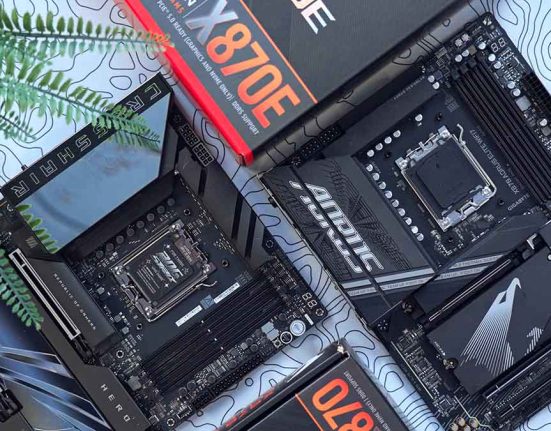MSI’s MAESTRO 300 is a wired gaming headset which aims to provide a sense of comfort and luxury to the entry-level market. Gaming headsets within the budget market tend to exclude key features and possess lacklustre build quality. Still, the MAESTRO 300 is built with comfort and customisation in mind, giving budget-oriented gamers an affordable option that emulates design elements found on the most luxurious gaming headsets. But to test whether the MAESTRO 300 can offer such an experience, we’ll evaluate this headset’s features, design, and audio quality, comparing it to a range of other gaming headsets along the way.
Wired gaming headsets are generally a better option for PC Gamers on a limited budget, as the sacrifice of connectivity opens up the possibility to include more premium features and forge a more robust, ergonomic design while keeping the price tag low. The MSI MAESTRO 300 is a prime example of this, as it includes a detachable microphone and software integration, which are often missing in low-end wireless designs. In this review, we’ll be assessing the MSI MAESTRO 300 in great detail to determine whether it brings enough to the table to justify picking up instead of a wireless gaming headset, as well as other wired options.
Specification
The MSI MAESTRO 300 offers all the criteria needed for a solid, budget-friendly gaming headset. For the most part, the performance lines up with what we’d expect from an affordable wired headset. The 40mm Neodymium drivers are loud enough to immerse yourself in games or block out sounds around you with music. In addition, the unidirectional pattern allows the microphone to focus on your voice and block out surrounding sounds.

However, the most surprising inclusion is the frequency response of the speakers. Most gaming headsets stick to a range of 20-20000Hz because it matches the frequency range of the human ear. However, the additional range on the MAESTRO 300 has its benefits, as it reduces distortion and improves audio clarity, leading to more accurate and detailed sound.
Weighing in at 258g with the mic attached, which is reduced to 247g with the mic detached, the MSI MAESTRO 300 doesn’t feel too heavy on the head, making it appropriate for prolonged gaming sessions. However, this gaming headset could cause some discomfort over time due to some design choices that will be addressed later.
| Key Specs | MSI MAESTRO 300 |
|---|---|
| Driver Unit | 40mm Neodymium |
| Speaker Frequency Response | 20 – 40000Hz |
| Microphone Pattern | Unidirectional (Cardioid) |
| Connectivity | USB Type-C |
| Battery Life | N/A |
| Compatibility | PC, Mac, PlayStation, Nintendo Switch, Android & iOS |
| Weight | 258g (w/ mic) |
Connectivity is arguably the weakest area of this design, with the wired USB Type-C connection bound to provide connectivity issues for anyone looking to use the MAESTRO 300 on a range of devices. Despite including a USB Type-C to USB Type-A dongle and support for a range of devices, the lack of wireless connectivity or audio jack reduces versatility, as it limits how this headset can be plugged in.
With an MSRP of $50, the MSI MAESTRO 300 is set to compete with the cheapest gaming headsets on the market. There is a vast range of gaming headsets available for around this price point, but they often lack additional design and performance features, something that the MSI MAESTRO 300 looks to address.
Design
With the MAESTRO 300 putting such a heavy focus on comfort and value, we’d expect the design to have some pleasant surprises in store. On the other hand, the budget restrictions are bound to lead to a few setbacks and weak spots.

After opening the box, the headset’s overall aesthetic stood out immediately. Many budget-friendly headsets tend to have a plain design that looks cheap, but the MAESTRO 300 avoids this thanks to the combination of a glossy finish and thick padding. While the design lacks luxuries such as RGB lighting, the headset looks clean and modern.
The MAESTRO 300 also features several practical design choices that aim to create a hassle-free gaming experience. Most notably, the detachable microphone alleviates a fraction of the weight and allows gamers to use the headset without risking damaging the mic when it’s not being used. The only downside is the position of the mic can’t be adjusted when attached, which means voice input will vary.

Another surprising feature of this headset is the alternative earcups that are packaged with the headset. The MAESTRO 300 includes breathable mesh earcups as standard but offers alternative protein leather earcups as well, which provide a softer feel at the expense of airflow. Switching the earcups around is also pretty easy, as the earcups click in and out of place. Though the protein leather earcups are slightly more comfortable, I recommend sticking to the breathable mesh because they are much better for longer gaming sessions.
The on-ear controls are also kept straightforward, with a volume rocker and mute switch on the left earcup. This makes it easy to adjust settings on the fly, and the simplicity benefits the controls by minimising incorrect inputs. That being said, the addition of a chat/game mixer would improve in-game controls without the need to rely on software.

When putting the headset on, this is where the cracks in the design begin to appear. To start with, the headset feels rigid and has lots of resistance when flexing. The positive is that this suggests the MAESTRO 300 is very durable, but the rigidity makes it feel tight, leading to discomfort over time. In addition, the weight distribution feels unbalanced, with the earcups feeling significantly heavier than the headband, which likely contributes to the tight feeling.
In a similar fashion, I have mixed opinions on the padding used for the headband. Initially, the headband was quite comfortable to wear and felt lightweight. However, over prolonged sessions, the comfort would slowly depreciate as the headband and earcups began to feel tighter. On top of this, having the padding attached directly to the headband raises concerns about how comfortable this headset will be after months of wear and tear.

It is worth noting that a lot of these issues are familiar on other gaming headsets within a similar price range, as they are restricted in the choice of materials. However, the likes of the SteelSeries Arctis Nova 1 and Logitech G335 prove more comfortable designs can be achieved within the same budget.
The MAESTRO 300 is rather accommodating regarding adjustability, which helps improve ergonomics. Along with multiple adjustment levels on the headband to match various head sizes, this headset includes rotatable earcups, allowing them to be placed on a flat surface without worrying about damage from scratches, slips, or falls.

Overall, plenty of design elements give the MAESTRO 300 plenty of ways to stand out from the competition, with a sleek aesthetic and swappable earcups for a tailored audio experience. Initially, this culminates in a design which feels as comfortable as more expensive gaming headsets. However, over longer gaming sessions, the MAESTRO 300 begins to feel tighter and heavier, and some of the design choices raise concerns over its ability to handle wear and tear.
Features We Like
Nahimic Studio
Software integration is one feature that most budget-oriented gaming headsets exclude, with the assumption being that most entry-level gamers won’t be interested in messing around with more advanced settings. However, the MAESTRO 300 takes the opposite approach, putting an emphasis on audio customisation via the Nahimic Studio for a tailored listening experience.
This software allows PC gamers to adjust a range of settings, as well as create multiple profiles for different tasks, and toggle advanced settings such as surround sound and volume stabilisation. Also, the interface is very user-friendly, with icons and descriptions for what each setting does, meaning you don’t need to be an audiophile to configure the best audio profile for your needs.
Detachable Microphone
Having the ability to remove the microphone from a gaming headset is very beneficial, especially for gamers who don’t partake in multiplayer titles. Not only does this make the headset lighter, but stopping the microphone from protruding reduces the risk of damaging the headset and makes it easier to put it down. Because of this, we’re happy to see this feature on the MAESTRO 300, as lots of budget-friendly headsets don’t allow the microphone to be removed.

Features We Don’t Like
No Earphone Jack
Whilst the USB Type-C connection is sufficient for most gaming platforms, the lack of support for a 3.5mm audio jack or even a 3.5mm dongle restricts the connectivity of this headset out of the box. As a result, this headset isn’t compatible with Xbox consoles, and could even lead to some complications when using some PC gaming handhelds and the Nintendo Switch.

Build Quality
One of my biggest concerns with the MSI MAESTRO 300 is the build quality, mainly in regard to the inconsistency throughout the design. Whilst there are some areas which offer impressive levels of comfort, such as the earcups and padded headband, the rigid main body and uneven weight distribution of the headset are not ideal for extensive use. When you consider that the padding on the earcups and headband are likely to fade over time due to general wear and tear, the longevity of this headset is questionable.

Audio Quality
Alongside using the MSI MAESTRO 300 over several days for gaming, video editing, and watching videos, we wanted to test the audio quality of the microphone and speakers of this headset mid-game. Therefore, I decided to boot up The Witcher III: Wild Hunt with the MSI MAESTRO 300 plugged into a gaming laptop.
The Gigabyte G6X gaming laptop used for this testing also ran quite loudly, which provided an excellent test of how the headset would deal with background noise. Below is a snippet of the audio test.
After listening to the test, the results lined up with what we’d expect to hear from a budget headset, which is slightly disappointing given the MAESTRO 300’s focus on audio customisation. My voice sounds echoey in the recording, but you can still clearly hear what I’m saying. On top of this, the whirring of the laptop fans can be heard constantly throughout the recording, which suggests the microphone struggles to isolate your voice from background noises, making it less than ideal for gamers in shared spaces and loud environments.
Conclusion
-
Features
-
Design
-
Performance
-
Value for Money
Summary
As a budget-friendly gaming headset, the MSI MAESTRO 300 is a solid choice for anyone looking for luxurious audio on a tight budget. Boasting a sophisticated design with several valuable features, such as swappable earcups, a detachable microphone, and software integration, there are plenty of selling points which allow this headset to stand out from other budget-friendly options already on the market.
But in practice, a few major concerns would make me think twice before picking this headset up over the alternatives. For example, the predominantly plastic and mesh design feels rigid, making it feel tight and uncomfortable over prolonged sessions while raising concerns over longevity. And though the audio quality on the speakers is impressive, the microphone quality left a lot to be desired during our testing. Whilst the MAESTRO 300 is a solid offering for the price, it does little to convince me that it is better than other budget-friendly gaming headsets already on the market.
Pros
✅ Clean aesthetic
✅ Customisation options
✅ Price point
Cons
❌ Wired connection
❌ Microphone quality
❌ Comfort over time








